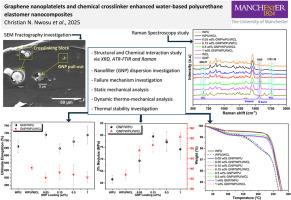Graphene nanoplatelets and chemical crosslinker enhanced water-based polyurethane elastomer nanocomposites
IF 14.2
1区 材料科学
Q1 ENGINEERING, MULTIDISCIPLINARY
引用次数: 0
Abstract
In this work, graphene nanoplatelets (GNP) and water-based crosslinker (WCL) were systematically employed to reinforce water-based polyurethane (WPU) matrix, offering strong enhancement in mechanical and thermal properties. It should be noted that unfunctionalised GNP as used in this study is known to be incompatible with water-based systems. Therefore, dispersing GNP in water-based elastomers (WBE) such as WPU was one of the problems addressed in this work by employing a novel water-bath technology. In addition, WCL was synergistically employed with GNP for the first time as a reinforcement in WPU. The research presents robust enhancement in mechanical properties realised through thorough static and dynamic mechanical analysis. With GNP/WPU and GNP/WPU/WCL nanocomposites achieving ∼13–25 % and ∼2.5–fold enhancement in modulus respectively across loadings of 0.05–1 wt% at low-strain, which is extremely crucial for high-performing elastomers. Interestingly, the effective toughening in mechanical properties achieved via GNP-alone was realised without loss in elongation, contrary to the result obtained for WCL-infused nanocomposites. As the unfunctionalised GNP showed only a slight crosslinking effect, in contrast to the huge crosslinking observed for the WCL-infused nanocomposites. Hence, the GNP-alone reinforced nanocomposites appear to offer effective recycling potential over those of WCL-infused nanocomposites, which is highly desirable for sustainable industrial applications. Understandably, through detailed analysis undertaken in this investigation employing state-of-the-art techniques such as Raman spectroscopy and scanning electron microscopy (SEM), this work has provided in-depth knowledge on the interaction of GNP and WCL with the WPU matrix. As well as their effects on elastomeric nanocomposites fracture-mechanisms, and structure-property relationship, which are desirable for wide-scale industrial applications.

石墨烯纳米片和化学交联剂增强水性聚氨酯弹性体纳米复合材料
在这项工作中,石墨烯纳米片(GNP)和水基交联剂(WCL)被系统地用于增强水性聚氨酯(WPU)基体,提供了强大的机械和热性能增强。应当指出,本研究中使用的未功能化国民生产总值已知与水基系统不相容。因此,将GNP分散到水基弹性体(WBE)中,如水基弹性体(WPU),是本研究采用新型水浴技术解决的问题之一。此外,WCL首次与GNP协同使用,作为WPU的补充。研究表明,通过全面的静态和动态力学分析,实现了机械性能的稳健增强。在低应变下,GNP/WPU和GNP/WPU/WCL纳米复合材料在0.05-1 wt%的载荷下分别实现了~ 13 - 25%和~ 2.5倍的模量增强,这对高性能弹性体至关重要。有趣的是,与注入wcl的纳米复合材料相反,仅通过gnp实现的机械性能的有效增韧没有损失延伸率。由于未功能化的GNP仅表现出轻微的交联效应,而注入wcl的纳米复合材料则表现出巨大的交联效应。因此,与注入wcl的纳米复合材料相比,单独的gnp增强纳米复合材料似乎具有有效的回收潜力,这对于可持续的工业应用是非常理想的。可以理解的是,通过采用最先进的技术(如拉曼光谱和扫描电子显微镜)进行的详细分析,这项工作提供了关于GNP和WCL与WPU矩阵相互作用的深入知识。以及它们对弹性纳米复合材料断裂机制和结构-性能关系的影响,这些都是大规模工业应用所需要的。
本文章由计算机程序翻译,如有差异,请以英文原文为准。
求助全文
约1分钟内获得全文
求助全文
来源期刊

Composites Part B: Engineering
工程技术-材料科学:复合
CiteScore
24.40
自引率
11.50%
发文量
784
审稿时长
21 days
期刊介绍:
Composites Part B: Engineering is a journal that publishes impactful research of high quality on composite materials. This research is supported by fundamental mechanics and materials science and engineering approaches. The targeted research can cover a wide range of length scales, ranging from nano to micro and meso, and even to the full product and structure level. The journal specifically focuses on engineering applications that involve high performance composites. These applications can range from low volume and high cost to high volume and low cost composite development.
The main goal of the journal is to provide a platform for the prompt publication of original and high quality research. The emphasis is on design, development, modeling, validation, and manufacturing of engineering details and concepts. The journal welcomes both basic research papers and proposals for review articles. Authors are encouraged to address challenges across various application areas. These areas include, but are not limited to, aerospace, automotive, and other surface transportation. The journal also covers energy-related applications, with a focus on renewable energy. Other application areas include infrastructure, off-shore and maritime projects, health care technology, and recreational products.
 求助内容:
求助内容: 应助结果提醒方式:
应助结果提醒方式:


